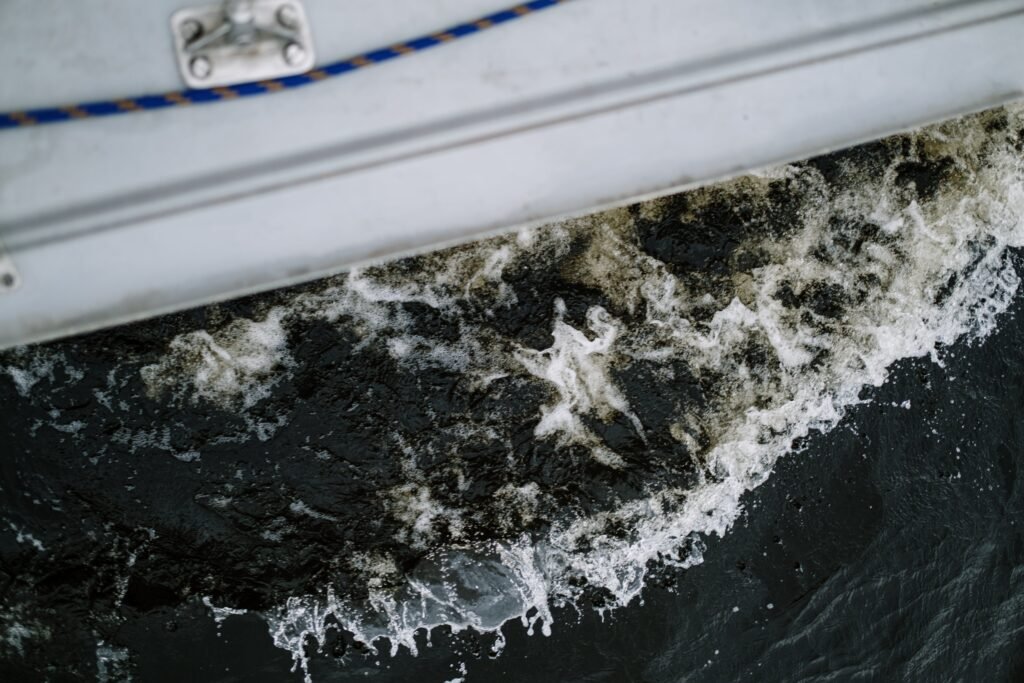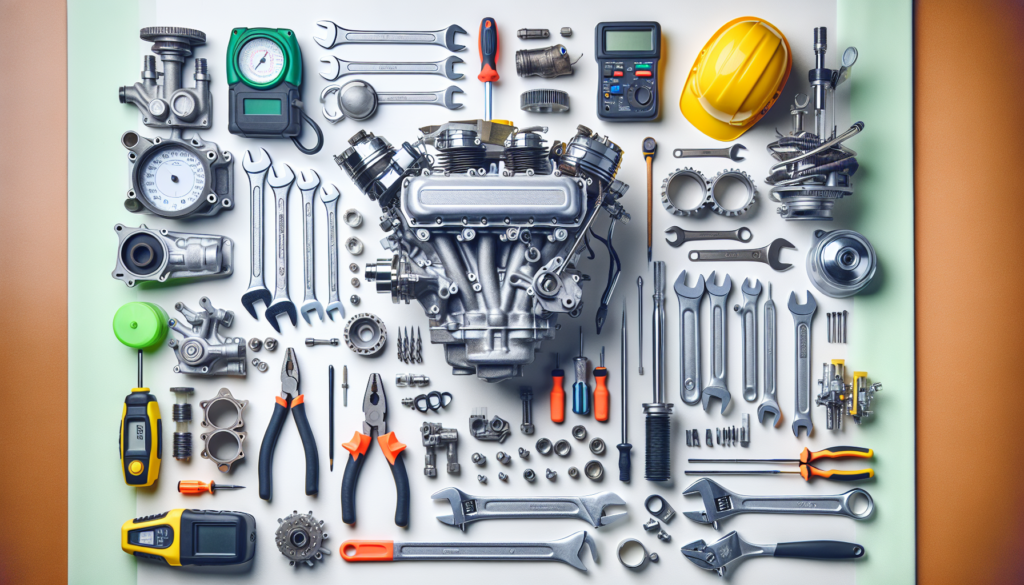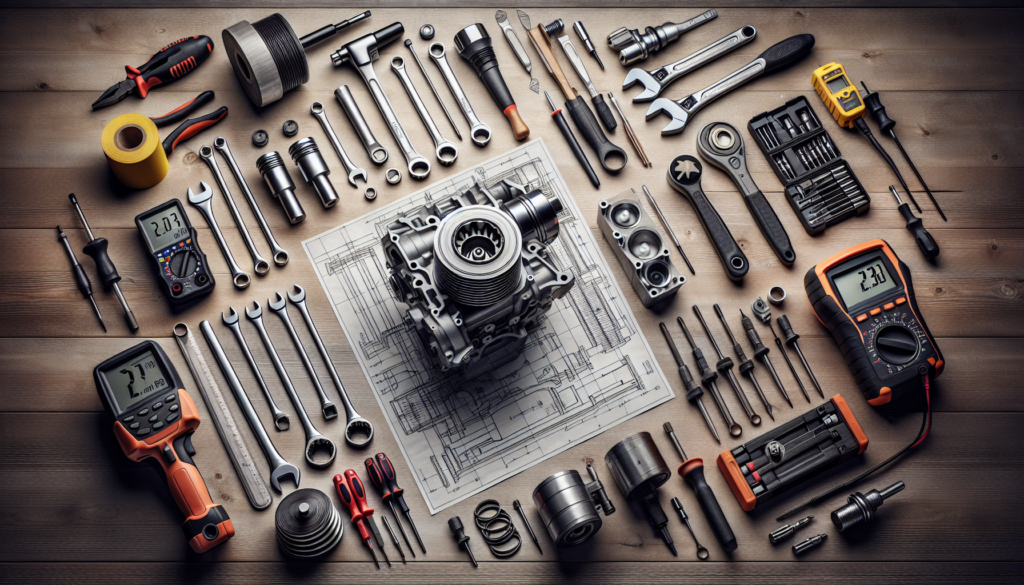If you are a boat enthusiast and enjoy tinkering with your boat’s engine, then having the right tools is essential. Whether you want to enhance the performance, increase fuel efficiency, or simply give your boat engine a much-needed upgrade, having the right tools can make all the difference. In this article, we will explore some of the essential tools that every DIY boat engine modifier should have in their toolbox. From wrenches and screwdrivers to diagnostic scanners and torque wrenches, we will cover everything you need to know to take your boat’s engine to the next level. Get ready to dive into the world of DIY boat engine modification!
1. Wrenches
Wrenches are a must-have tool for any DIY boat engine modification project. They are essential for tightening and loosening nuts and bolts, making them a versatile tool in your toolkit. Here are three types of wrenches that you should consider adding to your collection:
1.1 Combination Wrench
The combination wrench is a multipurpose tool that features both an open-end and a box-end. This allows you to tackle different types of fasteners with ease. The open-end is great for quick jobs and provides good leverage, while the box-end is ideal for tight spaces where you need more torque. With a combination wrench, you can handle a wide range of bolt sizes, making it a valuable tool to have in your arsenal.
1.2 Adjustable Wrench
An adjustable wrench, also known as a crescent wrench, is a versatile tool that can adapt to different bolt sizes. Its adjustable jaw allows you to tighten or loosen fasteners of various sizes, eliminating the need for multiple wrenches. This makes it a convenient choice when you’re working with different-sized nuts and bolts during your boat engine modification project. The adjustable wrench is also handy for situations where you don’t have the exact size wrench on hand.
1.3 Socket Wrench Set
A socket wrench set is an indispensable tool for boat engine modification. It consists of a ratcheting wrench and a set of detachable sockets. The ratcheting mechanism allows for quick and efficient tightening or loosening of fasteners, saving you time and effort. The sockets come in a variety of sizes, allowing you to tackle different bolt sizes, both metric and imperial. With a socket wrench set, you can easily access and work with fasteners in tight spaces, making it an essential tool for any boat engine modification project.
2. Screwdrivers
Screwdrivers are another essential tool that every DIY boat engine modifier needs. From removing screws to prying open panels, a good set of screwdrivers is invaluable. Here are three types of screwdrivers that should be in your toolkit:
2.1 Phillips Screwdriver
The Phillips screwdriver is easily recognizable by its cross-shaped tip. It is designed to engage with the cross-shaped slot on the head of a Phillips screw. This allows for better torque transfer and reduces the chances of the screwdriver slipping out of the slot. Phillips screws are commonly used in boat engines and having a Phillips screwdriver of various sizes ensures that you can tackle any screw you come across during your modification project.
2.2 Flathead Screwdriver
The flathead screwdriver, also known as a slotted screwdriver, features a flat, single-blade tip. It is the most basic and commonly used type of screwdriver. Flathead screws have a single slot on the head, and the flathead screwdriver engages with this slot for tightening or loosening the screw. Flathead screws are often found in various components of boat engines, so having a set of flathead screwdrivers of different sizes is essential for any DIY boat engine modification project.
2.3 Torx Screwdriver
The Torx screwdriver is a specialty screwdriver that is used for Torx screws. Torx screws have a six-point star-shaped head and require a corresponding Torx screwdriver for proper engagement. Boat engines often use Torx screws in specific areas, such as electrical connections, so having a Torx screwdriver set is crucial. It is recommended to have a set that includes various Torx sizes to ensure you have the right tool for the job.

3. Pliers
Pliers are versatile hand tools that are essential for any boat engine modification project. They are useful for gripping, bending, and cutting various materials. Here are three types of pliers that should be in your toolkit:
3.1 Needle-Nose Pliers
Needle-nose pliers have long, narrow jaws that taper to a point, resembling a pair of needle-like tips. These pliers are perfect for holding and manipulating small parts, reaching into tight spaces, and making precise bends. Needle-nose pliers are invaluable when it comes to electrical work on your boat engine, whether it’s connecting wires or removing delicate components. The fine, pointed tips allow for delicate and accurate handling of small parts.
3.2 Slip-Joint Pliers
Slip-joint pliers, also known as adjustable pliers, have a joint that can be adjusted to increase or decrease the jaw opening. This allows for a wide range of gripping capacities, making them versatile for different-sized fasteners and objects. Slip-joint pliers are great for grabbing and twisting objects, making them essential for tasks such as tightening hose clamps, manipulating small nuts and bolts, or holding objects firmly in place. They are a must-have tool for any boat engine modification project.
3.3 Locking Pliers
Locking pliers, commonly known as Vise-Grips, have a mechanism that allows them to lock onto objects and hold them securely. This makes them ideal for applications where you need a strong grip and the ability to clamp down on materials. Locking pliers are excellent for removing stubborn bolts or nuts, holding objects in place while you work on them, or providing an extra set of hands when needed. They are a versatile tool that can be used in various scenarios throughout your boat engine modification project.
4. Multimeter
A multimeter is an essential tool for any boat engine modifier, as it allows you to measure electrical parameters such as voltage, current, and resistance. It is crucial for diagnosing electrical issues, testing components, and ensuring proper electrical connections. Here are three types of multimeters that you should consider adding to your toolkit:
4.1 Digital Multimeter
Digital multimeters are the most common type on the market. They display readings as numerical values on a digital screen, making them easy to read and interpret. Digital multimeters often have various functions and settings, allowing you to measure voltage, current, resistance, and even perform continuity and diode tests. They are user-friendly, accurate, and a great choice for both beginners and experienced boat engine modifiers.
4.2 Analog Multimeter
Analog multimeters, also known as analog Volt-Ohm-Milliammeters (VOMs), use a mechanical needle to display readings on a dial. They are less common nowadays but are still favored by some professionals due to their ability to show instantaneous changes in readings. Analog multimeters are suitable for basic electrical measurements but may require more skill to interpret the results accurately. They can be a good backup option or a choice for those who prefer traditional analog displays.
4.3 Auto-Ranging Multimeter
Auto-ranging multimeters are a convenient option for those who frequently work with different voltage or resistance ranges. As the name suggests, these multimeters automatically select the appropriate range for the input being measured. This eliminates the need for manual range selection, making measurements faster and easier. Auto-ranging multimeters are ideal for boat engine modification projects where you may encounter a wide range of electrical values. They are user-friendly and reduce the chances of selecting an incorrect range.

5. Compression Tester
A compression tester is a specialized tool used to measure the compression pressure inside a boat engine’s cylinders. It is an essential tool for diagnosing engine issues and evaluating the condition of the engine’s internal components. Here are three components that make up a compression tester:
5.1 Pressure Gauge
The pressure gauge is the main component of a compression tester. It measures the compression pressure in the engine cylinders and displays the reading in PSI (pounds per square inch) or BAR (barometric pressure). A pressure gauge with a wide measurement range is ideal for boat engines with different compression requirements. The gauge should also be easy to read and accurate for reliable measurements.
5.2 Spark Plug Adapter
A spark plug adapter is used to connect the compression tester to the spark plug hole in the engine’s cylinder head. It allows the pressure gauge to measure the compression pressure directly from the cylinder. Spark plug adapters are designed to fit various spark plug sizes, making them compatible with different boat engines. It is essential to select the correct adapter size to ensure a proper seal and accurate compression readings.
5.3 Valve Holder
A valve holder is a tool that helps hold the engine’s valves in a closed position during the compression testing process. It prevents the valves from opening while the engine is being cranked, allowing accurate pressure measurements. Valve holders come in different shapes and designs, depending on the engine type and configuration. It is crucial to select a valve holder that is compatible with your boat engine to ensure accurate and reliable compression readings.
6. Timing Light
A timing light is a vital tool for boat engine modification projects that involve adjusting the ignition timing. It allows you to precisely measure and set the timing of the engine, ensuring optimal performance. Here are three types of timing lights that you should consider having in your toolkit:
6.1 Xenon Timing Light
Xenon timing lights are the most common type of timing light used by boat engine modifiers. They use a xenon gas-filled bulb that produces a bright flash of light when triggered. Xenon timing lights are simple to use and provide accurate timing measurements. They can be used with most boat engines and provide reliable results for adjusting ignition timing.
6.2 Digital Timing Light
Digital timing lights are a more advanced type of timing light that offers additional features and functionalities. They often come with a digital display that shows the timing value directly, making it easier to read and adjust. Digital timing lights may also have built-in features such as RPM measurement and advanced timing functions. They are a great choice for boat engine modifiers who require more precise timing adjustments or want additional features for their projects.
6.3 Inductive Timing Light
Inductive timing lights are designed to clamp over the boat engine’s spark plug wires without requiring direct electrical connections. They are convenient to use and do not interfere with the normal operation of the engine. Inductive timing lights use the spark signal from the spark plug wire to trigger the timing light, making them suitable for most boat engines. They are easy to use and an excellent choice for boat engine modifiers who prefer a hassle-free timing light solution.

7. Feeler Gauge
A feeler gauge is a precision tool used to measure the clearance or gap between two parts. It is essential for boat engine modification projects that involve adjusting valve lash or other critical clearances. Here are three types of feeler gauges that you should consider adding to your toolkit:
7.1 Metric Feeler Gauge Set
Metric feeler gauge sets are designed for measuring clearances in metric units. They consist of several thin, precision-sized blades that are marked with the corresponding metric values. Metric feeler gauges are suitable for boat engines that use metric measurements for critical clearances. The set should include a broad range of thicknesses to cover various clearance requirements.
7.2 Imperial Feeler Gauge Set
Imperial feeler gauge sets are similar to metric sets but are designed for measuring clearances in imperial units (inches). They come with precision-sized blades marked with the corresponding imperial values. Imperial feeler gauges are suitable for boat engines that use imperial measurements for critical clearances. It is important to select the correct feeler gauge set based on the measurement system used in your boat engine.
7.3 Bent Feeler Gauge
A bent feeler gauge is a specialized feeler gauge that features a bent or curved shape. It is used to access and measure gaps or clearances in hard-to-reach areas. The bent shape allows for easier insertion and manipulation in tight spaces. Bent feeler gauges are particularly useful when checking valve clearances in boat engines, where access can be challenging. Including a bent feeler gauge in your toolkit will ensure that you can accurately measure clearances even in the most difficult-to-reach areas.
8. Torque Wrench
A torque wrench is a precision tool used to apply a specific amount of torque to fasteners. It is crucial for boat engine modification projects where precise torque specifications are required to prevent overtightening or undertightening of bolts. Here are three types of torque wrenches that you should consider adding to your toolkit:
8.1 Click-Type Torque Wrench
Click-type torque wrenches are the most common type of torque wrenches used by boat engine modifiers. They produce an audible click when the desired torque value is reached, alerting you to stop applying force. Click-type torque wrenches are easy to use and provide accurate torque measurements. They often come with a wide torque range and are suitable for most boat engine modification projects.
8.2 Beam-Type Torque Wrench
Beam-type torque wrenches use a calibrated beam or dial to indicate the applied torque value. They are simple and reliable, with no internal mechanisms or moving parts. The torque value is determined by the deflection or angle of the beam, which provides a visual indication of the torque being applied. Beam-type torque wrenches are durable and do not require calibration, making them a cost-effective and low-maintenance option for boat engine modifiers.
8.3 Electronic Torque Wrench
Electronic torque wrenches are advanced tools that use electronic sensors to measure and display torque values. They often come with a digital display that shows the applied torque in real-time. Electronic torque wrenches can provide additional features such as memory storage, data logging, and customizable settings. They are ideal for boat engine modifiers who require precise torque measurements, especially in high-performance engines or specialized applications.

9. Fuel Pressure Gauge
A fuel pressure gauge is a tool used to measure the fuel pressure in a boat engine’s fuel system. It is vital for diagnosing fuel system issues, ensuring proper fuel delivery, and optimizing engine performance. Here are three types of fuel pressure gauges that you should consider adding to your toolkit:
9.1 Manual Fuel Pressure Gauge
Manual fuel pressure gauges are the most common type and are widely used by boat engine modifiers. They consist of a gauge connected to a hose and a fitting that can be attached to the fuel system for pressure measurement. Manual fuel pressure gauges are easy to use and provide accurate readings. They often come with a wide range of pressure scales and can be used across different fuel systems.
9.2 Digital Fuel Pressure Gauge
Digital fuel pressure gauges use electronic sensors to measure and display fuel pressure readings. They often have a digital display that shows the pressure in real-time, making it easier to read and interpret. Digital fuel pressure gauges may also come with additional features such as data logging or customizable settings. They are a great choice for boat engine modifiers who prefer digital displays or require advanced features for their projects.
9.3 Fuel Injection Pressure Tester
Fuel injection pressure testers are specialized tools used specifically for testing and diagnosing fuel injection systems. They combine the functionality of a fuel pressure gauge with additional features for testing fuel injectors, fuel pumps, and related components. Fuel injection pressure testers often come with adapters and fittings to ensure compatibility with different fuel injection systems. They are essential for boat engine modifiers working on fuel-injected engines and can provide comprehensive fuel system diagnostics.
10. Adjustable Propeller Wrench
An adjustable propeller wrench is a specialized tool used to remove and install propellers on boat engines. It is crucial for boat engine modification projects that involve propeller replacement or maintenance. Here are three types of adjustable propeller wrenches that you should consider adding to your toolkit:
10.1 Universal Wrench
Universal propeller wrenches are versatile tools that can fit various propeller sizes and types. They often have adjustable jaws or blades and can accommodate different shapes of propeller hub nuts. Universal wrenches are convenient for boat engine modifiers who work with different propellers on various boat engines. They provide a secure grip while allowing for easy removal and installation of propellers.
10.2 Heavy-Duty Wrench
Heavy-duty propeller wrenches are designed for larger and more robust propellers. They feature a sturdy construction and provide additional leverage for handling larger propeller hub nuts. Heavy-duty wrenches are ideal for boat engines with high horsepower or propellers with larger diameters. They ensure a secure grip and make propeller removal and installation easier and safer.
10.3 Slim Wrench
Slim propeller wrenches are designed for propellers with limited clearance between the hub nut and surrounding components. They have a slim profile that allows them to access tight spaces without interfering or damage. Slim wrenches are essential for boat engine modifiers working on propellers located in confined areas. They provide a secure grip while allowing for precise control and maneuverability.
Conclusion
Having the right tools is crucial for successful DIY boat engine modification projects. From wrenches and screwdrivers for general tasks to specialized tools like multimeters and propeller wrenches, each tool serves a specific purpose in making your boat engine modification project a breeze. By investing in a comprehensive toolkit, you’ll be well-equipped to tackle any task that comes your way and ensure a successful boat engine modification experience. Happy modifying!


